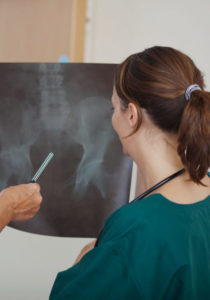
If you have hip pain, you know the toll it can take on your life. When your hips hurt, even simple actions like climbing stairs can be really uncomfortable. Other activities like running or playing sports can start to seem downright impossible when you’re trying to limit your symptoms. In order to reduce or eliminate your symptoms, you need to figure out what’s causing that pain in the first place.
Lots of people assume hip pain is almost always caused by issues related to overuse or wear and tear. And to some degree, that makes sense — a lot of hip pain is caused by those issues. But for about 10% to 15% of the population, a condition called hip impingement might be to blame.
What is hip impingement?
Your hip joint is a ball-and-socket joint — in fact, it’s the biggest ball-and-socket joint in your body. The top, rounded part of your thigh bone (femur) forms the ball, while a curved part of your pelvis (the acetabulum) forms the socket. The medical term for hip impingement — femoroacetabular impingement or FAI — derives its name from these two joint components.
In a normal hip, the ball is nicely rounded and the cup is smooth and evenly-formed. That means the hip moves the way it’s supposed to, without pain or excess friction. In FAI, the hip joint is malformed, and that means there’s a lot more rubbing and friction inside the joint. There are three types of FAI, depending on the type of malformation:
- CAM impingement occurs when the ball part of the joint is misshapen, which means it can’t rotate smoothly inside the socket.
- Pincer impingement occurs when the socket is malformed — typically when a bony overgrowth extends over the edge of the socket. This bony growth winds up “pinching” the ball of the joint and irritating or even tearing the connective tissues that support the joint.
- Combined impingement involves both CAM and pincer deformities.
Hip impingement can cause symptoms at any age, but it’s especially common in younger people. Sometimes, these deformities in the joint begin at birth, while in other people, they develop as the bones are growing.
What does hip impingement feel like?
FAI can cause a wide array of symptoms. Depending on the type of FAI you have and other factors, the symptoms can vary from mild to severe. The most common symptoms of hip impingement include:
- Stiffness in the groin or inner hip area
- Pain when rotating the hip
- Pain or stiffness when standing up after a long period of sitting
- Hip pain after strenuous physical activity or when walking uphill
- Pain or stiffness when getting into or out of a car
- A popping or clicking sensation when you move your hip
- Decreased range of motion in your hip
- Pain in your thigh or in the buttock area
In the early stages of FAI or when the deformity isn’t severe, your symptoms might be very mild or intermittent. As the condition progresses, those symptoms can become a lot worse, eventually interfering with your regular daily activities. If FAI symptoms cause you to change the way you walk or perform other activities, you might also experience knee pain or back pain, as well.
How do you treat hip impingement?
Before any treatment begins, you’ll need to have a hip evaluation to determine if FAI is present. During your examination, Dr. Van Thiel will perform a hip impingement test — a sequence of movements designed to pinpoint your symptoms. There are two hip impingement tests — the FADIR (flexion, adduction, and internal rotation) test and the FABER (flexion, abduction, and external rotation) test. In both tests, you’ll lie on your back while Dr. Van Thiel gently moves your leg. In one test, he’ll move your leg toward the center of your body; in the other, he’ll move it away from your body. Throughout each test, he’ll ask you to describe what you’re feeling.
The symptoms you experience can help him determine if you have a hip impingement.
FAI treatment usually begins conservatively, with simple hip impingement exercises designed to strengthen the muscles that support the hip. These exercises help reduce the strain on the joint, while also improving your range of motion. Other conservative options include:
- Resting the hip
- Altering your activities to reduce hip strain
- Taking oral anti-inflammatory medications
When these options don’t provide relief, FAI surgery might be considered. In most cases, surgery can be performed arthroscopically, using a very small incision and special instruments to smooth the joint surfaces. Arthroscopy is usually performed on an outpatient basis, and because the incision is so small, recovery typically is much faster than with traditional procedures.
What’s causing your hip pain?
Lots of people put off seeing a doctor for their hip pain, mainly because they worry they’ll need a hip replacement. But the fact is, most types of hip pain don’t require surgery. And when surgery is the better choice, procedures are performed using minimally-invasive techniques to restore the existing joint, not to replace it. If you’ve got hip pain, stop putting off treatment. As a top-ranked orthopaedic specialist in Rockford, Dr. Van Thiel can help you find the treatment you need to start feeling better. To schedule your evaluation, contact the office of Dr. Van Thiel today.
Dr. Van Thiel treats patients from all over Wisconsin and Illinois including Rockford, Elgin, Huntley, Dekalb, Crystal Lake, Barrington, McHenry, and Beloit.




